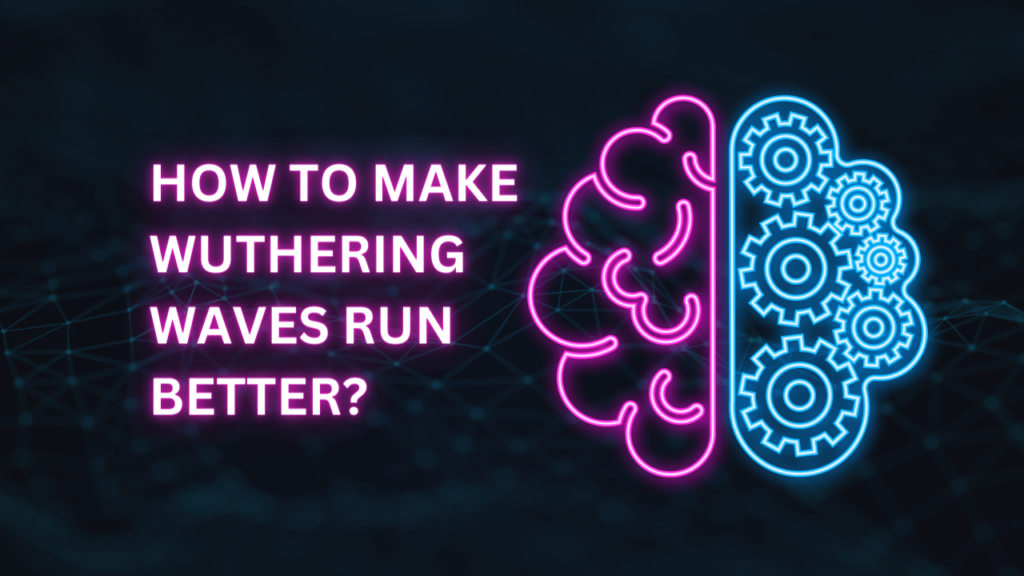How to Make Wuthering Waves Run Better? Wuthering Waves, the thrilling free-to-play action role-playing game from Kuro Games, has captivated players worldwide with its immersive gameplay, stunning visuals, and epic storytelling.
However, as with many resource-intensive games, players may encounter performance issues, stuttering, or lag, which can hamper their gaming experience. In this comprehensive guide, we’ll explore various techniques and optimizations to help you make Wuthering Waves run smoother and more efficiently on your gaming rig.
Optimize Your System
- Update Your Drivers
Keeping your system drivers up-to-date is crucial for optimal performance and stability. Outdated drivers can lead to various issues, including compatibility problems, performance bottlenecks, and even system crashes.
- Graphics Card Drivers: Updating your graphics card drivers is arguably the most important step in ensuring smooth gameplay. Graphics drivers are responsible for communicating with your GPU and translating game instructions into stunning visuals. Manufacturers like NVIDIA and AMD regularly release driver updates that improve performance, fix bugs, and add support for new games and features.
- Sound Card Drivers: While not as critical as graphics drivers, sound card drivers also play a role in ensuring seamless audio performance. Outdated sound drivers can cause audio glitches, crackling, or even complete sound loss.
- Chipset Drivers: Chipset drivers manage the communication between your CPU, RAM, and other components. Keeping them updated can improve system stability and performance, especially if you’ve recently upgraded your hardware.
To update your drivers, visit the manufacturer’s website (e.g., NVIDIA, AMD, Intel) and download the latest versions specific to your hardware. Alternatively, you can use driver update utilities like Driver Booster or DriverPack Solution to automate the process.
- Close Background Applications
Running too many applications in the background can significantly impact your system’s performance, especially when playing resource-intensive games like Wuthering Waves. Here are a few steps to minimize background processes:
- Task Manager: Press Ctrl + Shift + Esc to open the Task Manager, and navigate to the “Processes” tab. Here, you can identify resource-hungry applications and end them if necessary.
- Startup Programs: Many programs automatically start when you boot your computer, consuming valuable system resources. To manage startup programs, press Ctrl + Shift + Esc to open the Task Manager, then navigate to the “Startup” tab. Right-click on any unnecessary programs and select “Disable” to prevent them from launching at startup.
- Browser Extensions: While browser extensions can be useful, too many of them can slow down your system. Disable or remove any unnecessary extensions, especially those that run continuously in the background.
- Disable Antivirus and Firewall Temporarily
Antivirus and firewall software are essential for protecting your system from malware and other threats, but they can also impact game performance. Some antivirus programs may flag game files as potentially harmful or interfere with game processes, causing stuttering or freezing.
- Windows Defender: If you’re using Windows Defender, you can temporarily disable it while playing Wuthering Waves. Open the Start menu, search for “Windows Security,” and select the “Virus & threat protection” option. Under “Virus & threat protection settings,” click “Manage settings,” and toggle off the “Real-time protection” option.
- Third-Party Antivirus Software: For third-party antivirus solutions like Kaspersky, Bitdefender, or Malwarebytes, consult their documentation or support resources for instructions on temporarily disabling real-time protection or adding exceptions for Wuthering Waves.
Remember to re-enable your antivirus and firewall after you’ve finished playing to maintain your system’s security.
- Manage Virtual Memory
Virtual memory, also known as a paging file, is an area on your hard drive that Windows uses as an extension of your physical RAM. When your system runs out of available RAM, it starts using the paging file to store data, which can significantly impact performance. Here are a few tips for managing virtual memory:
- Increase or Customize Paging File Size: By default, Windows automatically manages the paging file size, but you can manually increase or customize it for better performance. Right-click on the Start menu, select “System,” and then “Advanced system settings.” Under the “Advanced” tab, click “Settings” in the “Performance” section. In the new window, select the “Advanced” tab again, and click “Virtual memory change.” Deselect the “Automatically manage paging file size for all drives” option, and then choose a custom initial and maximum size for your paging file.
- Move Paging File to Faster Storage: If you have a solid-state drive (SSD) or a faster hard drive, consider moving your paging file to that drive for improved performance. In the same “Virtual Memory” window, select the drive you want to use for the paging file and follow the prompts to configure it.
Game Settings Optimization
- In-Game Graphics Settings
Wuthering Waves offers a wide range of graphics settings that can significantly impact performance. Striking the right balance between visual quality and smooth gameplay is essential. Here are some key settings to consider:
- Resolution: Higher resolutions like 4K or 1440p require more GPU power, so lowering the resolution to 1080p or even 720p can improve performance on less capable systems.
- Texture Quality: Textures play a vital role in creating detailed environments and character models, but they can also be resource-intensive. Lowering the texture quality can free up GPU resources for better frame rates.
- Shadow Quality: Shadows add depth and realism to the game world, but they can be demanding on hardware. Reducing shadow quality or disabling certain shadow effects can boost performance.
- Anti-Aliasing: Anti-aliasing smooths out jagged edges in the game, but it comes at a performance cost. Lowering or disabling anti-aliasing can provide a noticeable performance boost, especially on older GPUs.
- Anisotropic Filtering: This setting improves the quality of textures at oblique angles, but it can be resource-intensive. Reducing or disabling anisotropic filtering can improve frame rates.
- Effects Quality: Wuthering Waves features various visual effects like particle effects, bloom, and depth of field. Lowering the quality of these effects can significantly improve performance without drastically impacting the overall visual experience.
- Advanced Settings
In addition to the standard graphics settings, Wuthering Waves offers several advanced options that can further optimize performance:
- Vertical Synchronization (V-Sync): V-Sync synchronizes the game’s frame rate with your monitor’s refresh rate, reducing screen tearing but potentially introducing input lag. Disabling V-Sync can improve frame rates but may cause visual artifacts.
- Frame Rate Cap: Wuthering Waves allows you to cap the maximum frame rate, which can improve performance and reduce GPU load on systems with weaker graphics cards.
- Triple Buffering: This setting can help reduce stuttering and improve frame pacing, but it may also introduce input lag. Experiment with enabling or disabling triple buffering to find the best balance.
- Tessellation: Tessellation adds more geometric detail to surfaces, but it can be demanding on your GPU. Lowering the tessellation level or disabling it entirely can boost performance, especially on older graphics cards.
- Audio Settings
While Wuthering Waves is primarily a visually intensive game, adjusting audio settings can also impact performance:
- Audio Quality: Lowering the audio quality can reduce CPU and RAM usage, potentially improving overall system performance.
- Audio Channels: Reducing the number of audio channels can free up resources, but it may also impact the quality of positional audio and surround sound.
- Voice Chat Settings: If you’re not using in-game voice chat, consider disabling it to conserve resources.
Hardware Upgrades
If you’ve exhausted all software optimizations and still experience performance issues, upgrading your hardware may be the best solution. Here are some key components to consider upgrading:
- Upgrade CPU
The CPU (Central Processing Unit) is the brain of your computer, responsible for handling game logic, physics calculations, and AI routines. A more powerful CPU can significantly improve overall game performance, especially in CPU-bound scenarios.
- Multicore and Hyperthreading: Modern CPUs feature multiple cores and hyperthreading capabilities, allowing them to handle multiple tasks simultaneously. Games like Wuthering Waves can take advantage of these technologies, so opting for a CPU with more cores and hyperthreading support can provide a noticeable performance boost.
- Clock Speed and IPC: Higher clock speeds and improved instructions per cycle (IPC) translate to faster processing power. However, clock speed alone isn’t the only factor; newer CPU architectures can offer better IPC and overall performance, even at lower clock speeds.
- Upgrade Graphics Card
The graphics card, or GPU (Graphics Processing Unit), is responsible for rendering the game’s visuals. Upgrading to a more powerful GPU can drastically improve frame rates, enable higher graphics settings, and provide a smoother overall experience.
- GPU Architecture: Modern GPU architectures from NVIDIA and AMD offer significant performance improvements over older generations, with better compute capabilities, enhanced features, and more efficient power management.
- VRAM Capacity: Games like Wuthering Waves can consume a substantial amount of video memory (VRAM). If your current GPU has limited VRAM, upgrading to a model with more VRAM can prevent texture streaming issues and improve overall visual quality.
- Cooling Solutions: High-end GPUs generate a significant amount of heat, so adequate cooling is essential for maintaining stable performance and longevity. Consider upgrading to a graphics card with better cooling solutions, such as larger heatsinks or custom water-cooling setups.
- Upgrade RAM
While not as critical as the CPU and GPU, having sufficient and fast RAM (Random Access Memory) can also contribute to smoother gameplay in Wuthering Waves.
- Capacity and Speed: Modern games can consume a substantial amount of RAM, especially when running at higher resolutions or with mods installed. Upgrading to 16GB or more of high-speed RAM (e.g., DDR4-3200 or faster) can prevent bottlenecks and improve overall system responsiveness.
- Dual-Channel Configuration: Using two identical RAM modules in a dual-channel configuration can provide a performance boost by increasing memory bandwidth. Ensure your motherboard supports dual-channel mode and install matching RAM modules for optimal performance.
- Upgrade Storage
While storage drives don’t directly impact in-game performance, they can significantly affect load times and overall system responsiveness.
- Solid-State Drives (SSDs): Upgrading to an SSD, especially for your operating system and game installations, can dramatically reduce load times and improve overall system snappiness compared to traditional hard disk drives (HDDs).
- SATA vs. NVMe SSDs: NVMe SSDs, which connect directly to the PCIe bus, offer even faster read and write speeds than traditional SATA SSDs, resulting in quicker game load times and improved asset streaming.
- Cooling Solutions
Proper cooling is essential for maintaining stable performance and preventing thermal throttling, which can impact both CPU and GPU performance.
- CPU Coolers: Upgrading to a more powerful CPU cooler, such as a high-end air cooler or an all-in-one liquid cooling solution, can help keep your CPU running at optimal temperatures, even under heavy load.
- Case Fans: Ensuring adequate airflow within your computer case is crucial for dissipating heat from all components. Consider adding extra case fans or upgrading to higher-quality models for improved cooling performance.
- Liquid Cooling: For the ultimate in cooling performance, consider installing a custom liquid cooling loop for your CPU and GPU. These setups can effectively dissipate heat and allow for higher overclocking headroom, but they come at a higher cost and complexity.
Advanced Techniques
For experienced users and enthusiasts seeking even higher performance levels, several advanced techniques can be employed. However, these methods may carry risks and require a deeper understanding of hardware and software:
- Overclocking
Overclocking involves increasing the clock speeds of your CPU, GPU, or RAM beyond their factory-set specifications, potentially providing a significant performance boost in games like Wuthering Waves.
- CPU Overclocking: Modern CPUs often have built-in overclocking utilities or can be overclocked through the BIOS/UEFI settings. Increasing the CPU’s core clock speed and adjusting voltages can yield performance gains, but it also generates more heat and increases power consumption.
- GPU Overclocking: Similarly, you can overclock your GPU by increasing its core and memory clock speeds using software tools like MSI Afterburner or EVGA Precision X1. However, overclocking a GPU also increases power consumption and heat output, potentially requiring better cooling solutions.
- Stability Testing: When overclocking, it’s crucial to thoroughly test for stability using tools like Prime95 (for CPUs) and FurMark (for GPUs). Unstable overclocks can lead to system crashes, data corruption, and potentially hardware damage.
- Game Boosting and Optimization Tools
Several third-party tools are available that can help optimize game performance and provide additional features:
- Razer Cortex: This software from Razer can automatically detect and optimize game settings, as well as free up system resources by suspending unnecessary background processes.
- Intel Graphics Command Center: For systems with Intel integrated graphics, the Graphics Command Center offers optimization tools, game streaming capabilities, and performance monitoring features.
- NVIDIA GeForce Experience: NVIDIA users can take advantage of the GeForce Experience suite, which includes game optimization settings, driver updates, and game recording/streaming functionality.
- Windows Performance Tweaks
While Windows 10 and 11 are designed to provide a balanced experience, there are several tweaks and settings that can prioritize gaming performance:
- Game Mode: Windows 10 and 11 include a dedicated Game Mode that prioritizes CPU and GPU resources for running games, potentially improving performance and reducing latency.
- High-Performance Power Plan: Switching to the High-Performance power plan can allow your CPU and GPU to run at their maximum clock speeds, providing a performance boost at the cost of higher power consumption and heat output.
- Disable Visual Effects: Disabling certain visual effects and animations in Windows can free up system resources for games. However, this may also impact the overall user experience outside of gaming sessions.
Troubleshooting
Despite your efforts to optimize performance, you may still encounter issues or unexpected behavior while playing Wuthering Waves. Here are some troubleshooting steps to consider:
- Verify Game Files
Corrupted or missing game files can lead to various issues, including performance problems, crashes, and graphical glitches. Most digital distribution platforms, such as Steam, Epic Games Store, and Battle.net, offer tools to verify the integrity of your game files and repair any issues.
Steam:
- Launch the Steam client
- Right-click on Wuthering Waves in your library
- Select “Properties”
- Navigate to the “Local Files” tab
- Click “Verify Integrity of Game Files”
Epic Games Store:
- Launch the Epic Games Launcher
- Click on your library
- Click the three dots next to Wuthering Waves
- Select “Verify”
Battle.net:
- Open the Battle.net client
- Navigate to the Wuthering Waves game page
- Click the gear icon next to the “Play” button
- Select “Scan and Repair”
- Update Game and Drivers
Keeping your game and drivers up-to-date can resolve various performance issues, bug fixes, and compatibility problems.
- Check for Game Updates: Most digital distribution platforms will automatically notify you when a game update is available. However, you can also manually check for updates within the respective client (e.g., Steam, Epic Games Store, Battle.net).
- Update Graphics Drivers: As mentioned earlier, outdated graphics drivers can cause performance issues and other problems. Visit your GPU manufacturer’s website (NVIDIA or AMD) and download the latest drivers for your specific graphics card model.
- Disable Overlays and Recording Software
Certain third-party applications, such as game overlays and recording/streaming software, can interfere with game performance and cause issues like stuttering, freezing, or even crashes.
- GeForce Experience: If you’re using NVIDIA’s GeForce Experience, try disabling the in-game overlay by opening the application, navigating to “Settings,” and toggling off the “In-Game Overlay” option.
- Xbox Game Bar: Windows 10 and 11 include the Xbox Game Bar, which can sometimes conflict with games. To disable it, press the Windows key + G, then toggle off the “Game Bar” option.
- Discord: The popular communication app Discord includes an in-game overlay feature that can impact performance. Disable it by opening Discord, going to “User Settings” > “Game Overlay,” and toggling off the “Enable in-game overlay” option.
- Adjust In-Game Settings for Your Hardware
If you’re still experiencing performance issues after trying the above steps, it may be necessary to adjust the in-game settings to better match your hardware capabilities.
- Use Built-in Benchmarking Tools: Many modern games, including Wuthering Waves, include built-in benchmarking tools that can help you identify the optimal settings for your system. Run the benchmark and pay attention to the performance metrics and recommendations provided.
- Tweak Settings Based on Performance: If the benchmark results indicate that certain settings are causing performance bottlenecks, try lowering those specific settings until you achieve a stable and smooth frame rate. Remember to strike a balance between visual quality and performance based on your preferences.
Conclusion
Optimizing the performance of a resource-intensive game like Wuthering Waves can involve various techniques and strategies. By following the steps outlined in this guide, you can ensure a smooth and enjoyable gaming experience on your system.
Remember to start with the basics, such as updating drivers, closing background applications, and managing virtual memory. Then, dive into the in-game settings and advanced options to fine-tune the visuals and performance to your liking.
For those willing to invest in hardware upgrades, upgrading components like the CPU, GPU, RAM, and storage can provide significant performance boosts and future-proof your system for upcoming games.
Additionally, advanced techniques like overclocking, game boosting tools, and Windows performance tweaks can squeeze out even more performance, but should be approached with caution and a deep understanding of the potential risks.
Finally, don’t hesitate to troubleshoot any issues that may arise by verifying game files, updating drivers and the game itself, disabling overlays and recording software, and adjusting in-game settings based on your hardware capabilities.
With the right optimizations and tweaks, you can embark on epic adventures in the world of Wuthering Waves, immersing yourself in stunning visuals and seamless gameplay. Happy gaming!
FAQs
How can I check if my system meets the requirements for Wuthering Waves?
You can use various system information utilities to check the specifications of your computer. For Windows, you can press Windows key + R, type “dxdiag,” and hit Enter to open the DirectX Diagnostic Tool, which will provide information about your system’s CPU, RAM, GPU, and other components.
What graphics settings should I prioritize for better performance?
Generally, settings like resolution, texture quality, shadow quality, and anti-aliasing have the most significant impact on performance. Lowering these settings can provide a substantial boost in frame rates. However, the ideal settings will depend on your specific hardware configuration.
Can overclocking my CPU and GPU improve performance in Wuthering Waves?
Yes, overclocking your CPU and GPU can potentially provide a performance boost in Wuthering Waves, but it also increases power consumption, heat output, and the risk of system instability. Overclocking should be approached with caution and proper cooling solutions.
How much of an impact does RAM have on Wuthering Waves’ performance?
While RAM is not the primary bottleneck for most games, having sufficient and fast RAM can improve overall system responsiveness and prevent stuttering or hitching. Upgrading to 16GB or more of high-speed DDR4 RAM is recommended for optimal performance.
Is it worth upgrading to an SSD or NVMe drive for better load times?
Absolutely. Upgrading to an SSD, especially for your operating system and game installations, can significantly reduce load times and improve overall system responsiveness. NVMe SSDs offer even faster load times than traditional SATA SSDs.
Can third-party game optimization tools like Razer Cortex or NVIDIA GeForce Experience help improve performance?
Yes, these tools can automatically optimize game settings based on your hardware configuration and provide additional features like game recording, streaming, and driver updates. However, their effectiveness may vary depending on the game and your specific system.
How do I troubleshoot performance issues if I’m still experiencing problems after trying various optimizations?
Start by verifying the integrity of your game files, updating your game and drivers to the latest versions, and disabling any overlays or recording software that may interfere with the game. If the issues persist, try adjusting the in-game settings based on your hardware capabilities using the built-in benchmarking tools.
Can upgrading my CPU cooler or adding more case fans improve performance?
While not directly impacting performance, proper cooling solutions are essential for preventing thermal throttling and maintaining stable performance. Upgrading your CPU cooler, adding more case fans, or even considering liquid cooling can help keep your system running at optimal temperatures under heavy load.
Is it possible to optimize Wuthering Waves for laptops or lower-end systems?
Yes, Wuthering Waves offers a wide range of graphics settings that can be adjusted to suit lower-end or laptop systems. Additionally, techniques like closing background applications, managing virtual memory, and disabling anti-virus software temporarily can help improve performance on less powerful systems.







